Reducing the Use of Disposable Plastics through Public Engagement Campaigns: An Experimental Study of the Effectiveness of Message Appeals, Modalities, and Sources
Abstract
:1. Introduction
2. Literature Review
2.1. Gain- vs. Loss-Frame Messaging
2.2. Multimodality and Information Source
2.3. The Mediation Role of Emotion Responses
3. Method
3.1. Sample
3.2. Procedure
3.3. Measures
3.4. Manipulation Checks
4. Results
4.1. Effects of Experimental Stimuli
4.2. Moderation Effect and Mediation Effect
5. Discussion
6. Conclusions
Author Contributions
Funding
Institutional Review Board Statement
Informed Consent Statement
Data Availability Statement
Conflicts of Interest
Appendix A
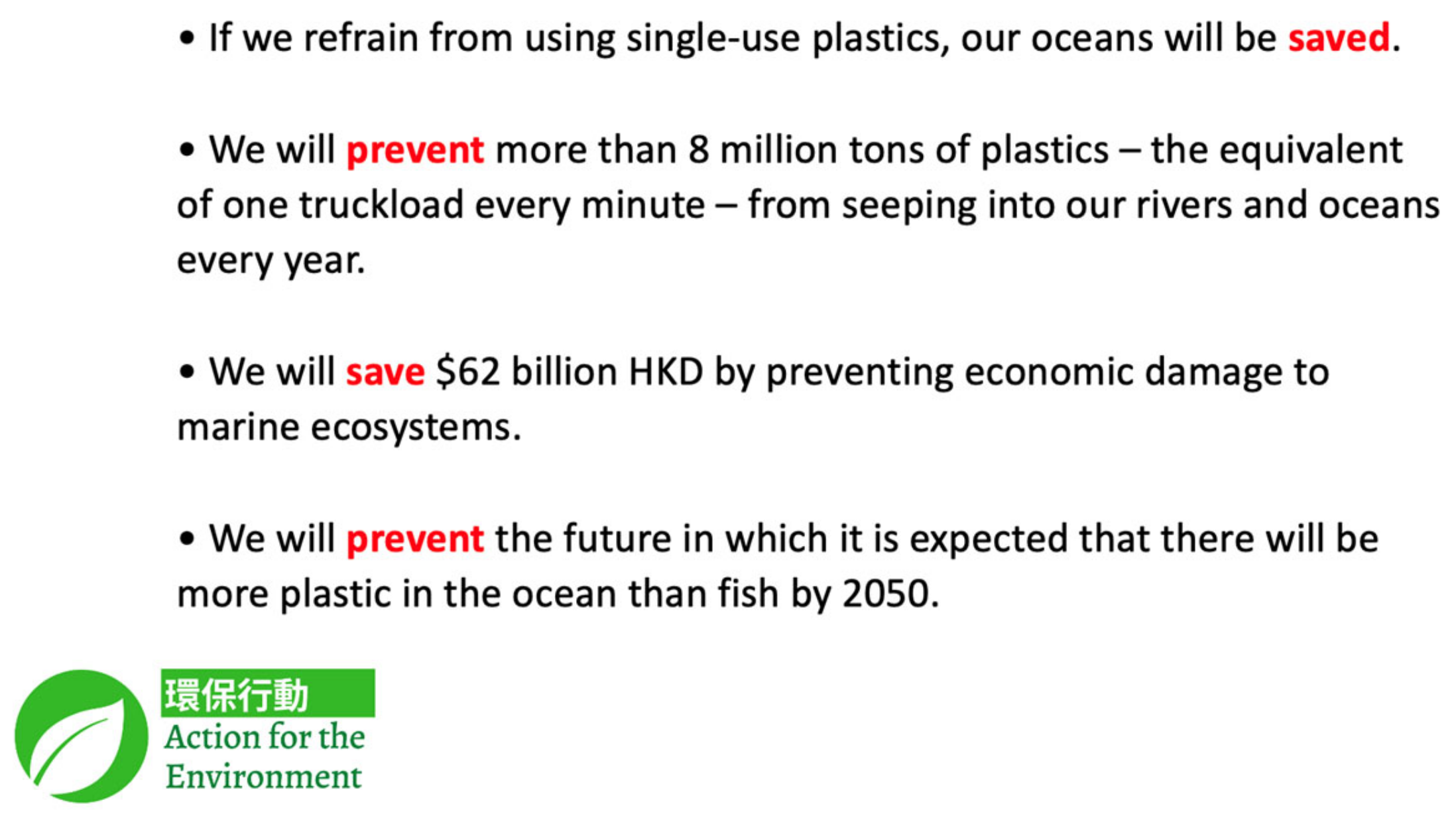
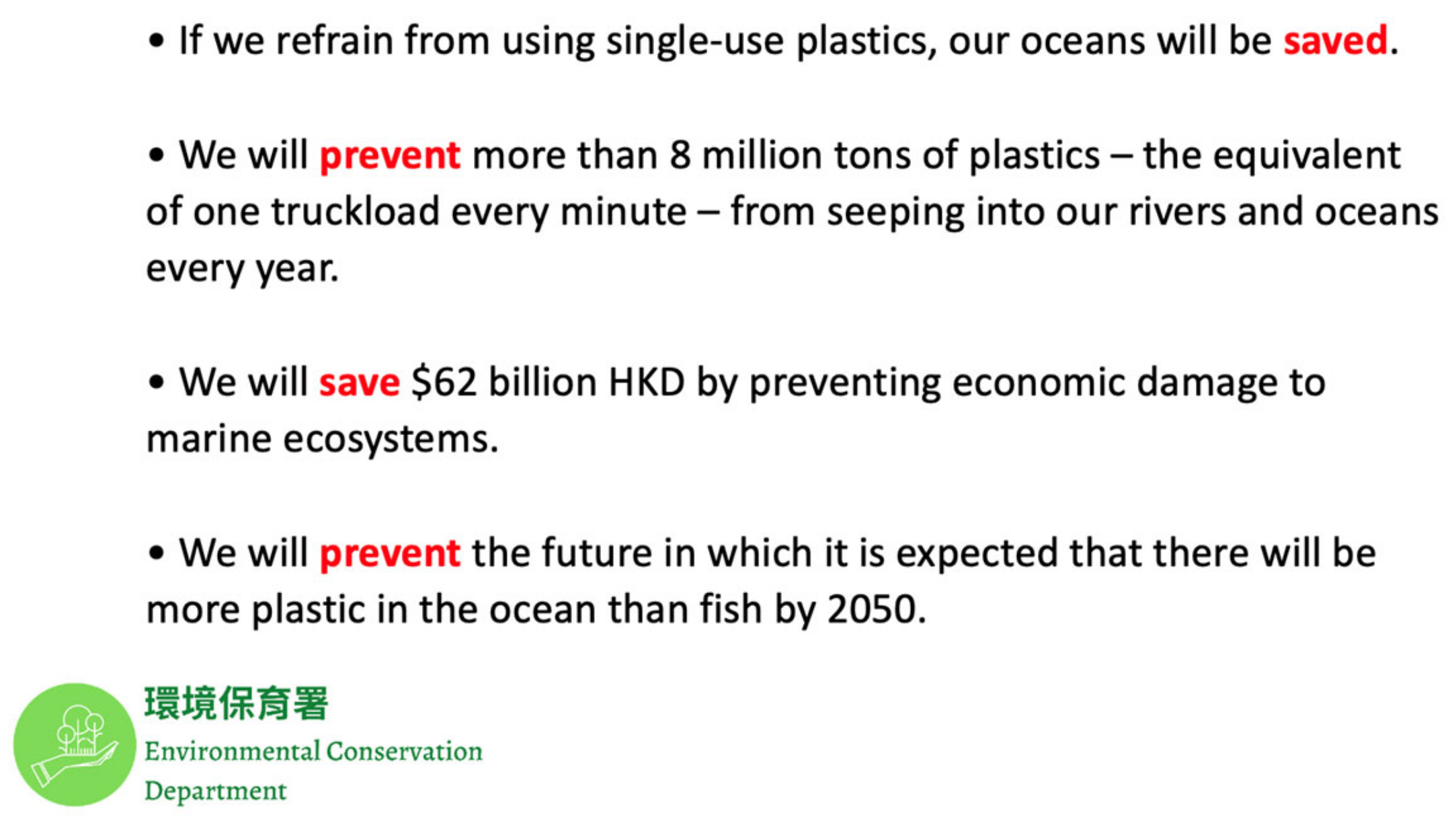

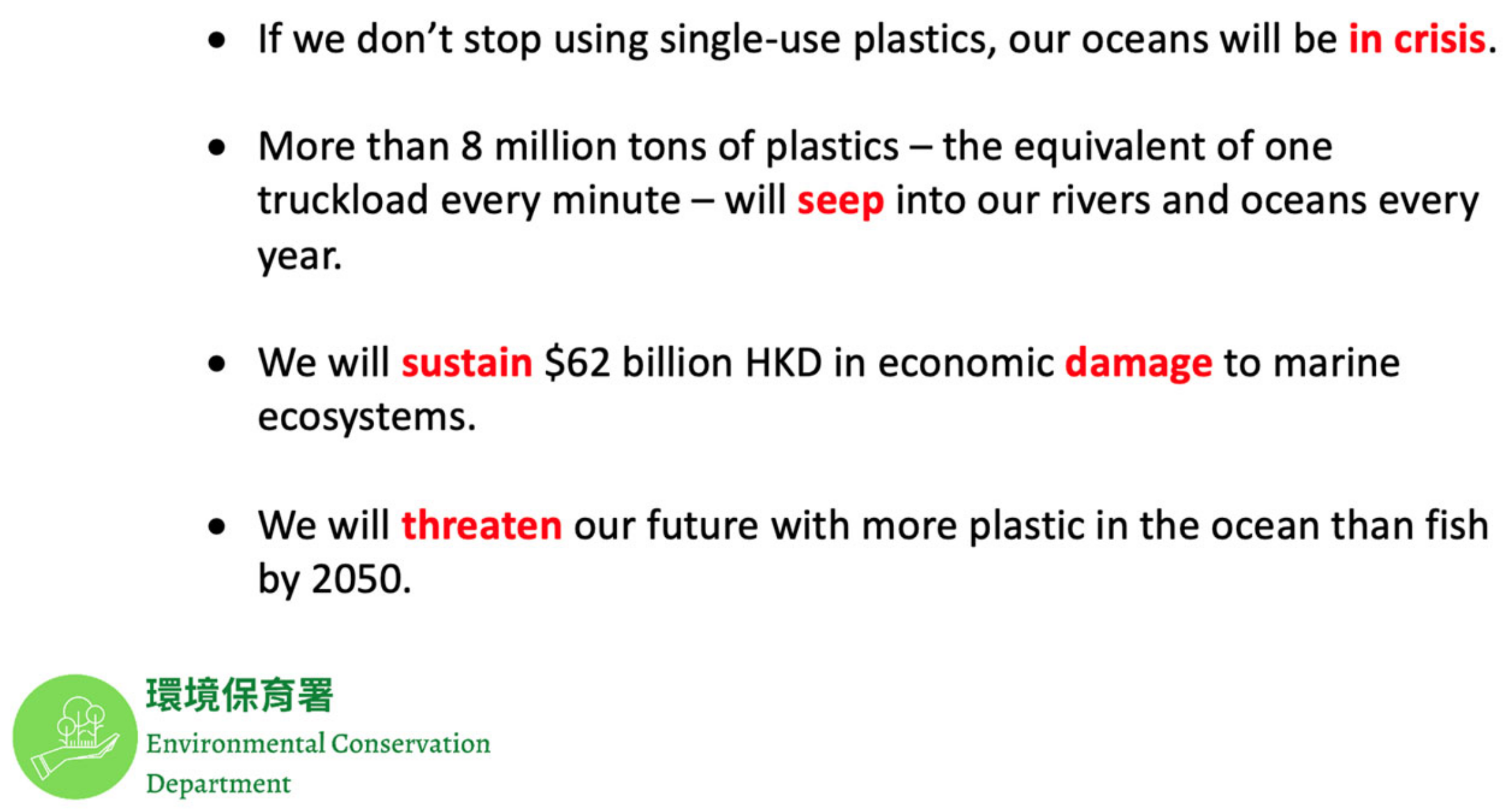
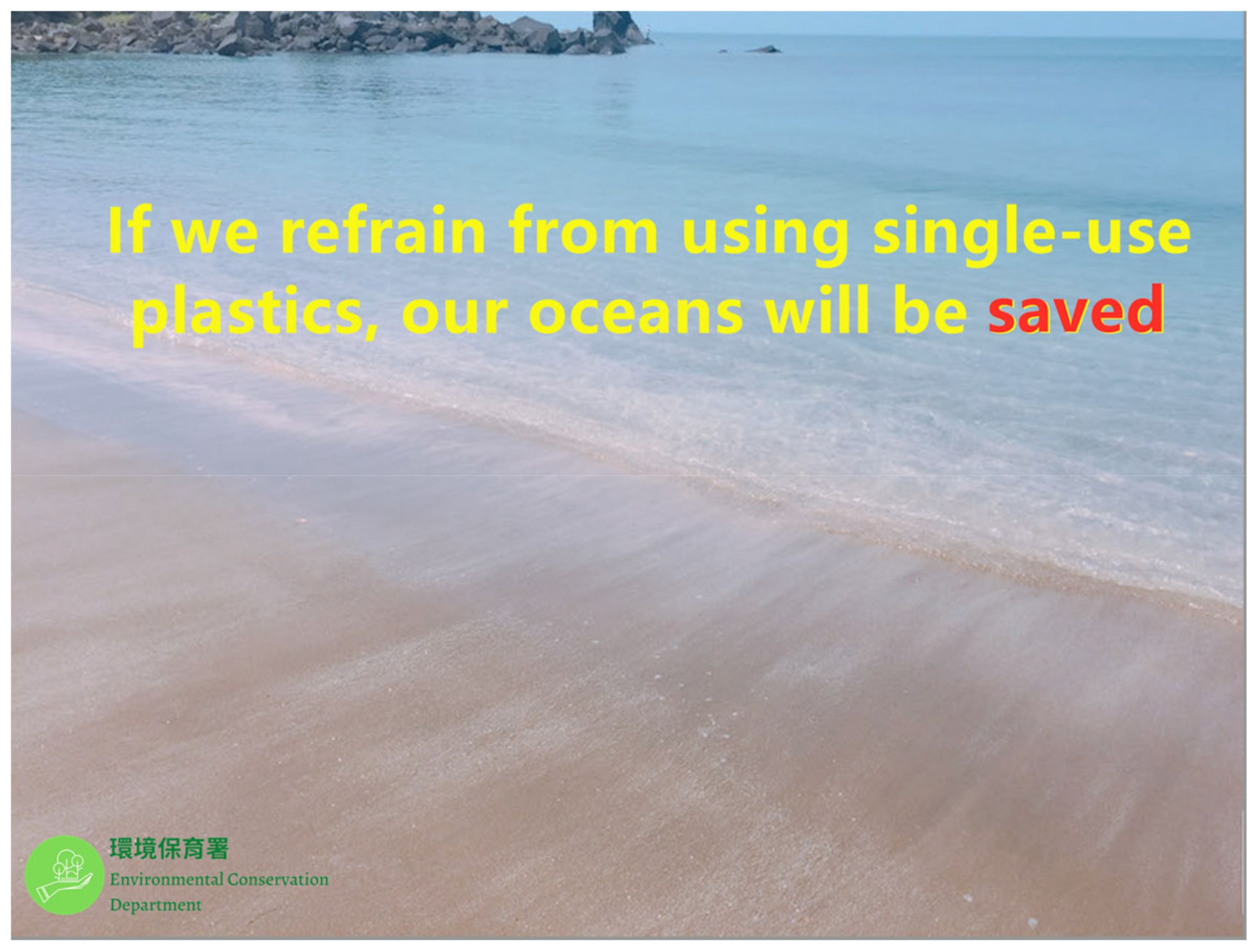
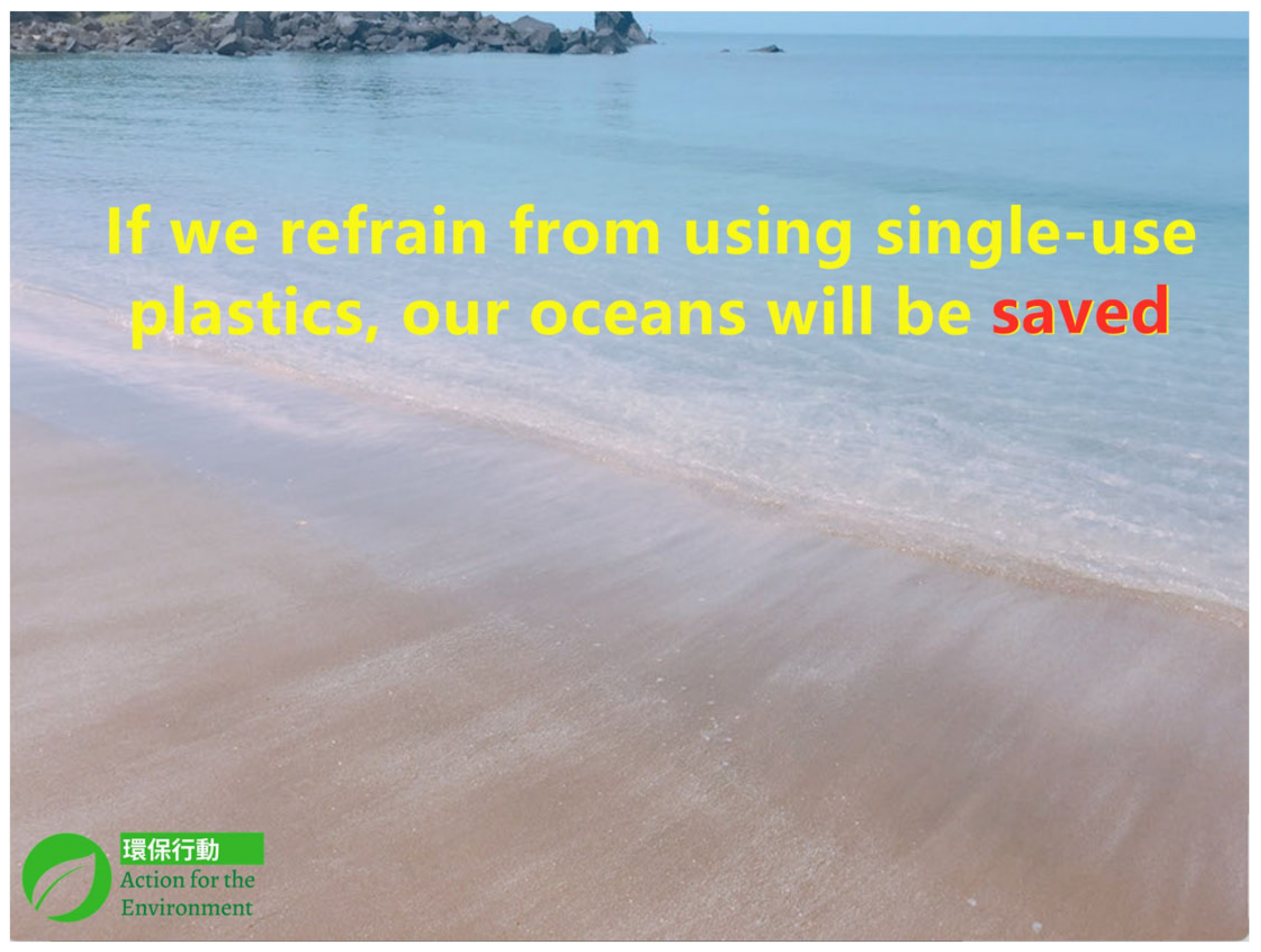

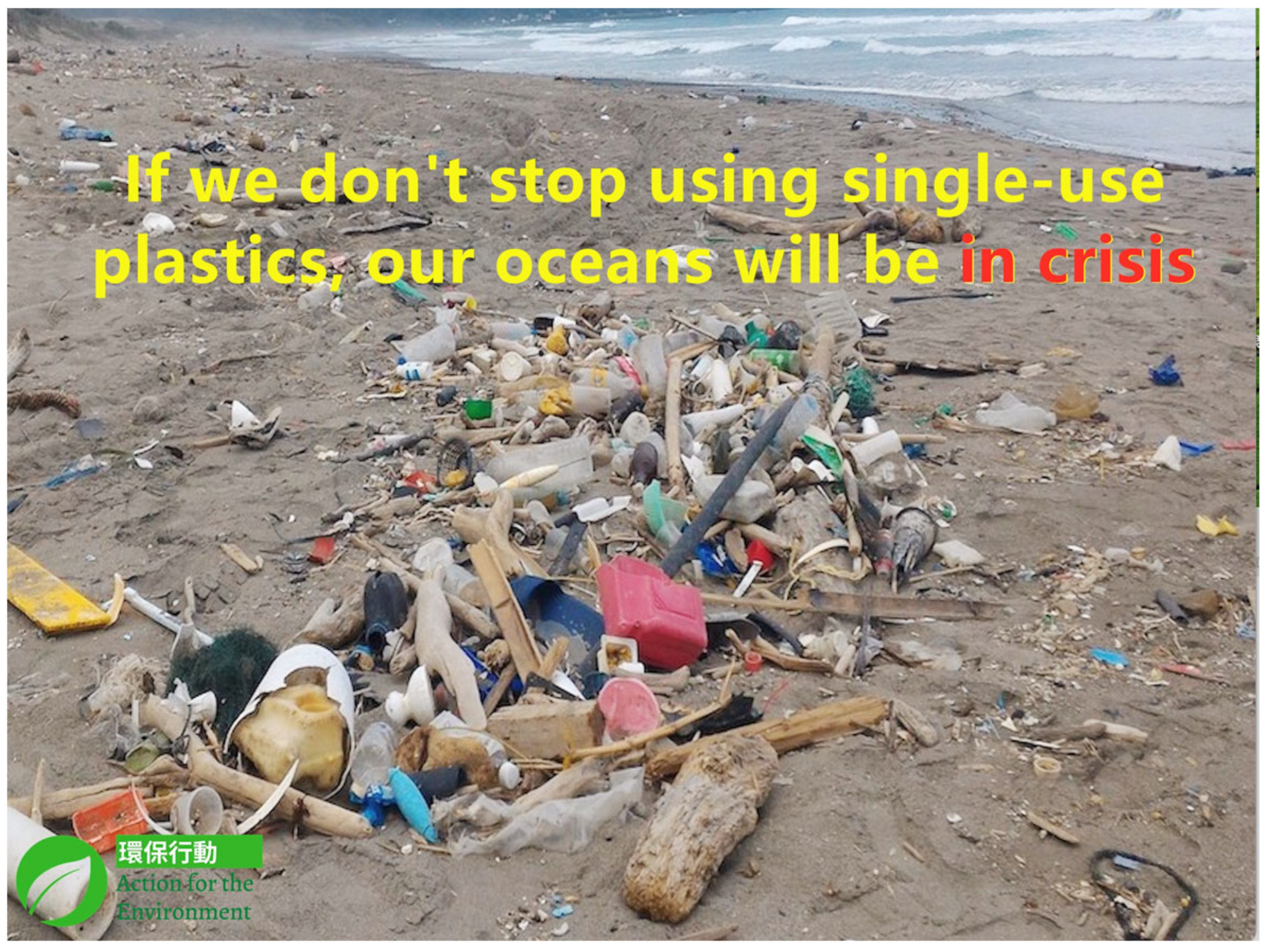
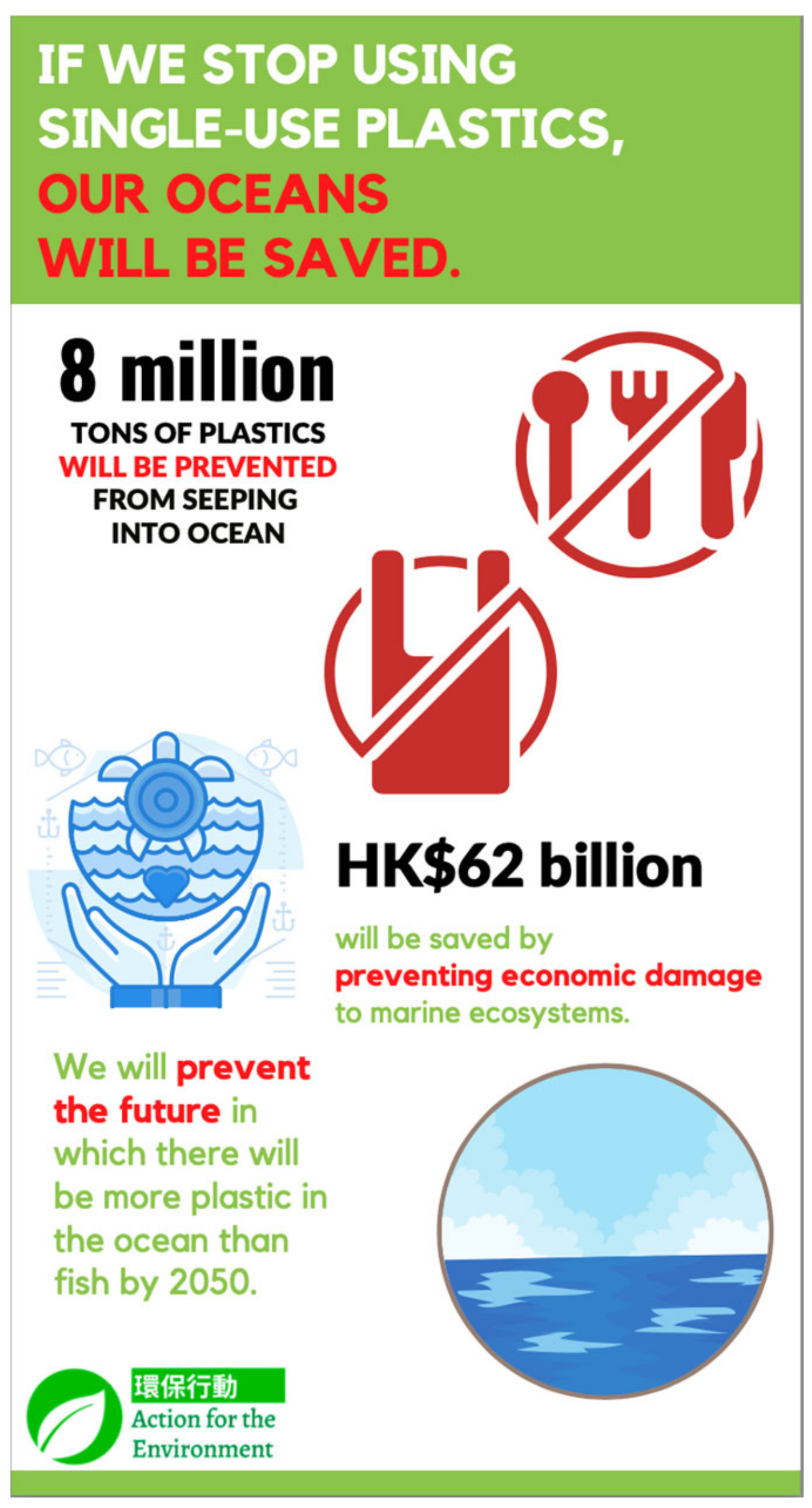
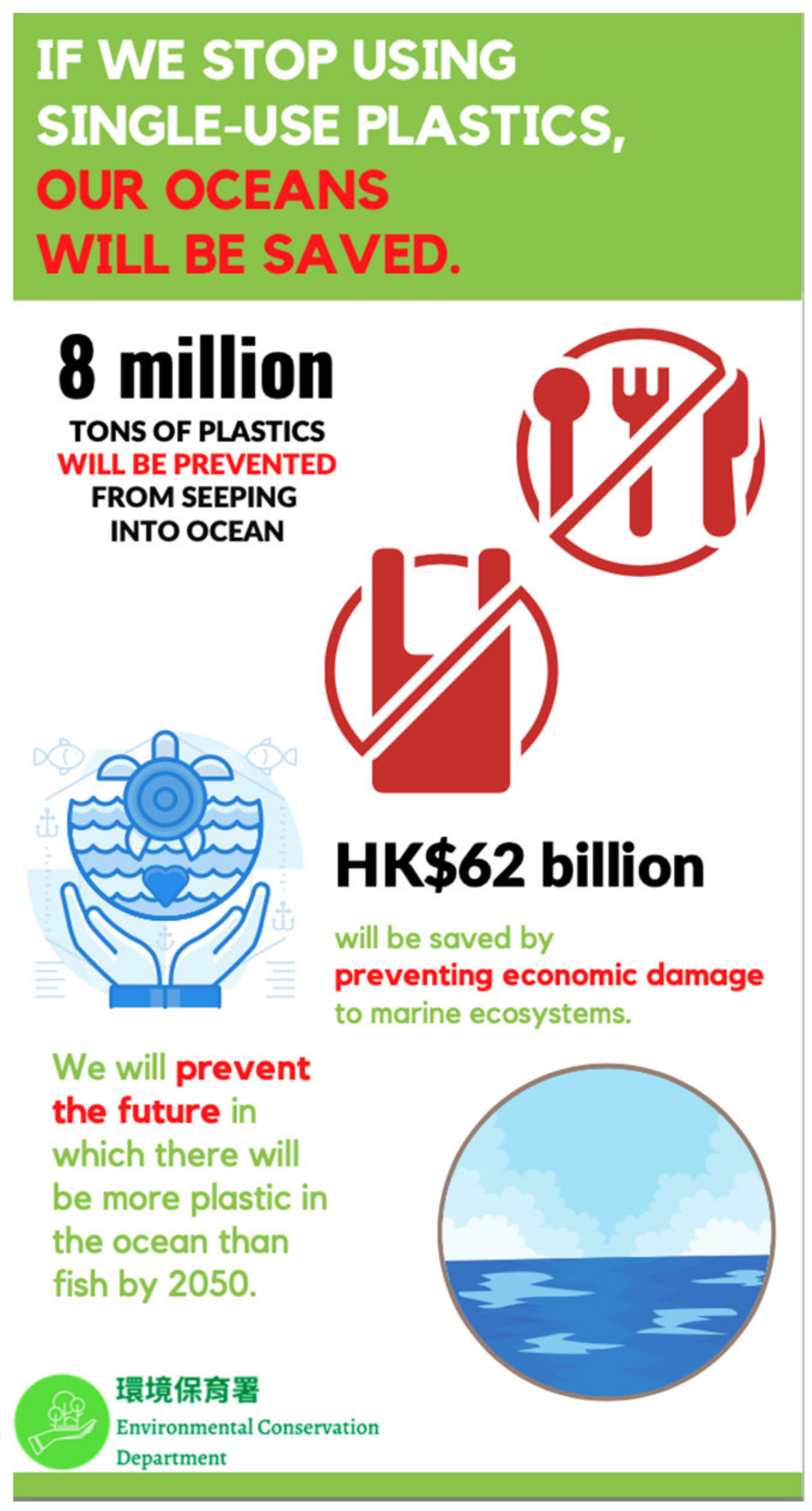
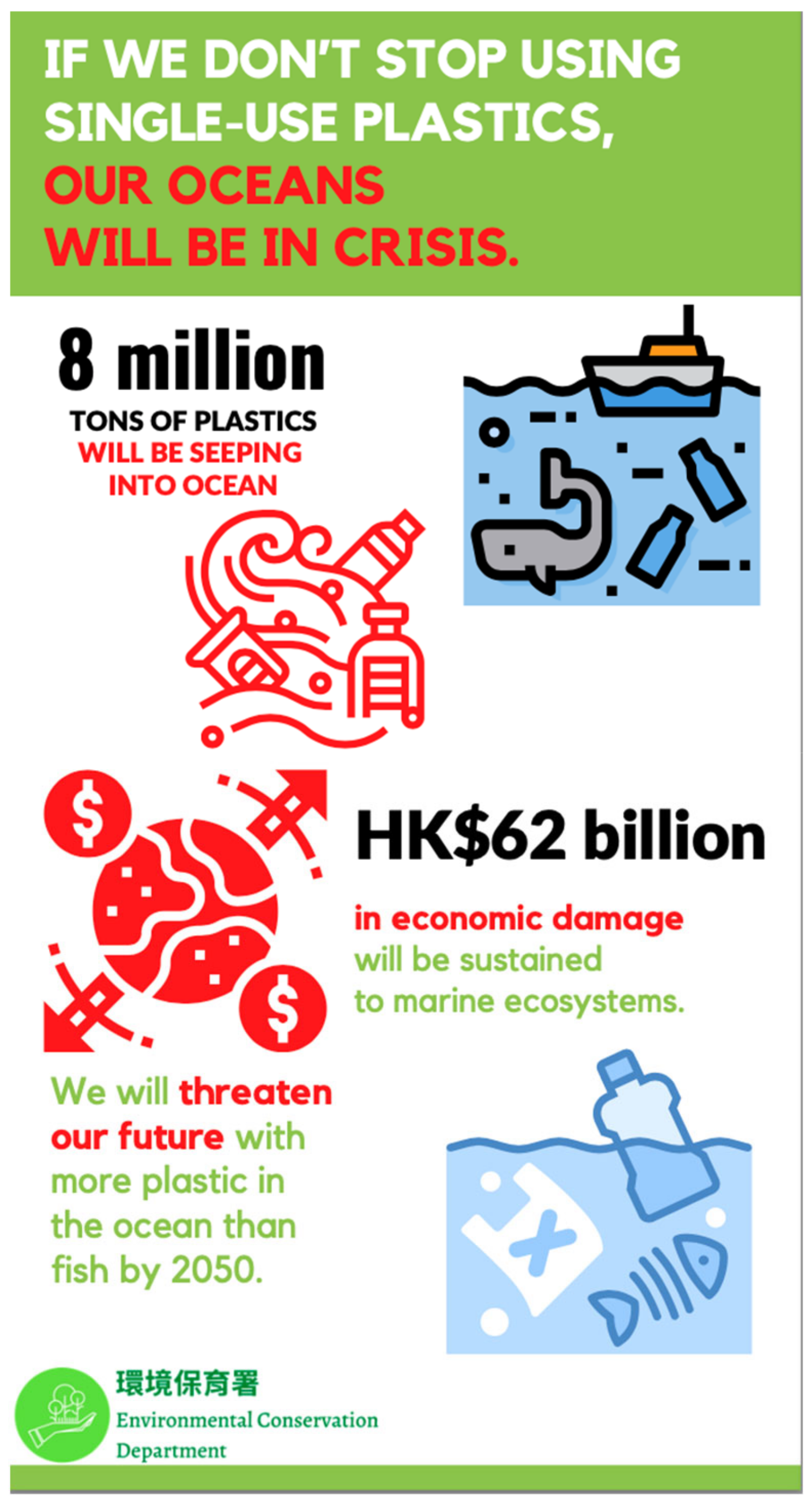

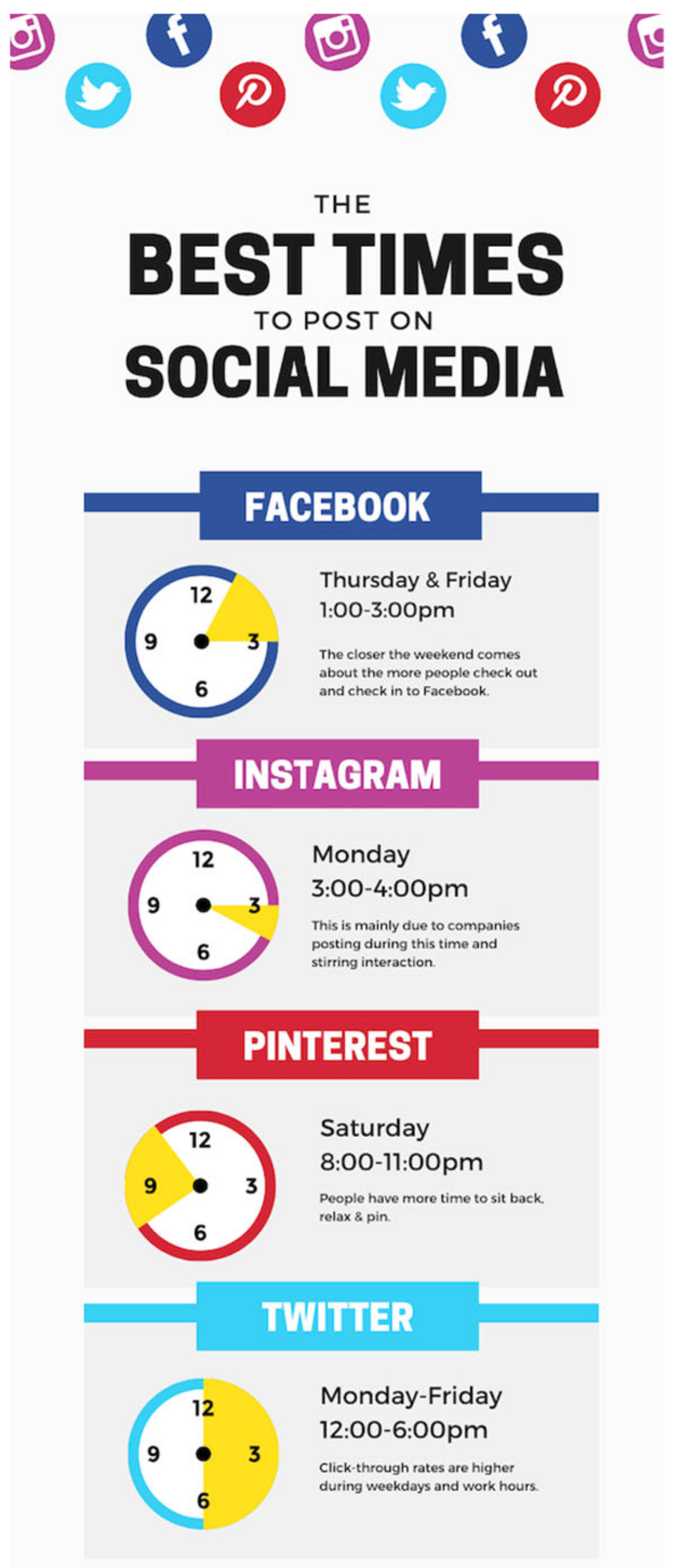
References
- Plastic Oceans International. The Facts. 2022. Available online: https://plasticoceans.org/the-facts/ (accessed on 26 June 2022).
- Beaumont, N.J.; Aanesen, M.; Austen, M.C.; Börger, T.; Clark, J.R.; Cole, M.; Hooper, T.; Lindeque, P.K.; Pascoe, C.; Wyles, K.J. Global ecological, social and economic impacts of marine plastic. Mar. Pollut. Bull. 2019, 142, 189–195. [Google Scholar] [CrossRef] [PubMed]
- Earth Org. China’s Refusal to Take Back Food Containers Exposes Hong Kong’s Broken Plastic Waste Management System. 2022. Available online: https://earth.org/hong-kongs-plastic-waste-management/ (accessed on 26 June 2022).
- Kareklas, I.; Carlson, J.R.; Muehling, D.D. The Role of Regulatory Focus and Self-View in “Green” Advertising Message Framing. J. Advert. 2012, 41, 25–39. [Google Scholar] [CrossRef]
- Liu, Z.; Liu, L.; Li, H. Determinants of information retweeting in microblogging. Internet Res. 2012, 22, 443–466. [Google Scholar] [CrossRef]
- Wang, X.; Chen, L.; Shi, J.; Peng, T.Q. What makes cancer information viral on social media? Comput. Hum. Behav. 2019, 93, 149–156. [Google Scholar] [CrossRef]
- Tversky, A.; Kahneman, D. The framing of decisions and the psychology of choice. Science 1981, 211, 453–458. [Google Scholar] [CrossRef] [Green Version]
- Bilandzic, H.; Kalch, A.; Soentgen, J. Effects of Goal Framing and Emotions on Perceived Threat and Willingness to Sacrifice for Climate Change. Sci. Commun. 2017, 39, 466–491. [Google Scholar] [CrossRef]
- Homar, A.R.; Cvelbar, L.K. The effects of framing on environmental decisions: A systematic literature review. Ecol. Econ. 2021, 183, 106950. [Google Scholar] [CrossRef]
- Westin, K.; Nordlund, A.; Jansson, J.; Nilsson, J. Goal framing as a tool for changing people’s car travel behavior in Sweden. Sustainability 2020, 12, 3695. [Google Scholar] [CrossRef]
- Greussing, E.; Boomgaarden, H.G. Promises and Pitfalls: Taking a Closer Look at How Interactive Infographics Affect Learning From News. Int. J. Commun. 2021, 15, 3336–3357. [Google Scholar]
- Huang, G.; Li, K.; Li, H. Show, not tell: The contingency role of infographics versus text in the differential effects of message strategies on optimistic bias. Sci. Commun. 2019, 41, 732–760. [Google Scholar] [CrossRef]
- Lazard, A.; Atkinson, L. Putting environmental infographics center stage: The role of visuals at the elaboration likelihood model’s critical point of persuasion. Sci. Commun. 2015, 37, 6–33. [Google Scholar] [CrossRef]
- Leiserowitz, A. Climate change risk perception and policy preferences: The role of affect, imagery, and values. Clim. Chang. 2006, 77, 45–72. [Google Scholar] [CrossRef] [Green Version]
- Severin, W.J. Another look at cue summation. AV Commun. Rev. 1967, 15, 233–245. [Google Scholar] [CrossRef]
- Paivio, A. Imagery and Verbal Processes; Holt, Rinehart, and Winston: New York, NY, USA, 1971. [Google Scholar]
- Flanagin, A.; Metzger, M.J. Digital Media and Perceptions of Source Credibility in Political Communication. In The Oxford Handbook of Political Communication; Kenski, K., Jamieson, K.H., Eds.; Oxford University Press: Oxford, UK, 2017; p. 417. [Google Scholar]
- Zhang, N.; Skoric, M.M. Getting their voice heard: Chinese environmental NGO’s Weibo activity and information sharing. Environ. Commun. 2020, 14, 844–858. [Google Scholar] [CrossRef]
- Manca, S.; Altoè, G.; Schultz, P.W.; Fornara, F. The persuasive route to sustainable mobility: Elaboration likelihood model and emotions predict implicit attitudes. Environ. Behav. 2020, 52, 830–860. [Google Scholar] [CrossRef]
- Rosenthal, S.; Ho, K.L. Minding other people’s business: Community attachment and anticipated negative emotion in an extended norm activation model. J. Environ. Psychol. 2020, 69, 101439. [Google Scholar] [CrossRef]
- Rakib, M.A.N.; Chang, H.J.; Jones, R.P. Effective Sustainability Messages Triggering Consumer Emotion and Action: An Application of the Social Cognitive Theory and the Dual-Process Model. Sustainability 2022, 14, 2505. [Google Scholar] [CrossRef]
- Gilovich, T.D.; Griffin, D.W. Judgment and Decision Making. In Handbook of Social Psychology; Fiske, S.T., Gilbert, D.T., Lindzey, G., Eds.; John Wiley: Hoboken, NJ, USA, 2010; Volume 1, pp. 542–589. [Google Scholar]
- Sawe, N.; Knuston, B. Neural valuation of environmental resources. NeuroImage 2015, 122, 87–95. [Google Scholar] [CrossRef] [Green Version]
- Heidbreder, L.M.; Steinhorst, J.; Schmitt, M. Plastic-free July: An experimental study of limiting and promoting factors in encouraging a reduction of single-use plastic consumption. Sustainability 2020, 12, 4698. [Google Scholar] [CrossRef]
- Walker, T.R.; McGuinty, E.; Charlebois, S.; Music, J. Single-use plastic packaging in the Canadian food industry: Consumer behavior and perceptions. Humanit. Soc. Sci. Commun. 2021, 8, 80. [Google Scholar] [CrossRef]
- Viera, J.S.; Marques, M.R.; Nazareth, M.C.; Jimenez, P.C.; Castro, Í.B. On replacing single-use plastic with so-called biodegradable ones: The case with straws. Environ. Sci. Policy 2020, 106, 177–181. [Google Scholar] [CrossRef]
- Lu, H. The Effects of Emotional Appeals and Gain Versus Loss Framing in Communicating Sea Star Wasting Disease. Sci. Commun. 2016, 38, 143–169. [Google Scholar] [CrossRef]
- Segev, S.; Fernandes, J.; Wang, W. The Effects of Gain Versus Loss Message Framing and Point of Reference on Consumer Responses to Green Advertising. J. Curr. Issues Res. Advert. 2015, 36, 35–51. [Google Scholar] [CrossRef]
- Newman, C.L.; Howlett, E.; Burton, S.; Kozup, J.C.; Tangari, A.H. The influence of consumer concern about global climate change on framing effects for environmental sustainability messages. Int. J. Advert. 2012, 31, 511–527. [Google Scholar] [CrossRef]
- O’Keefe, D.J.; Jensen, J.D. The relative persuasiveness of gain-framed and loss-framed messages for encouraging disease detection behaviors: A meta-analytic review. J. Commun. 2009, 59, 296–316. [Google Scholar] [CrossRef]
- Cho, H.; Boster, F.J. Effects of gain versus loss frame antidrug ads on adolescents. J. Commun. 2008, 58, 428–446. [Google Scholar] [CrossRef]
- Mitkidis, P.; Chrysochou, P.; Obolevich, V.; Mitkidis, K. Effectiveness of environmental health and loss framing on household pharmaceutical take-back schemes. Waste Manag. 2022, 143, 61–68. [Google Scholar] [CrossRef]
- Leshner, G.; Cheng, I.-H. The Effects of Frame, Appeal, and Outcome Extremity of Antismoking Messages on Cognitive Processing. Health Commun. 2009, 24, 219–227. [Google Scholar] [CrossRef]
- Robberson, M.R.; Rogers, R.W. Beyond fear appeals: Negative and positive persuasive appeals to health and self-esteem. J. Appl. Soc. Psychol. 1988, 18, 277–287. [Google Scholar] [CrossRef]
- Lee, H.; Cameron, G.T. Utilizing audiovisual and gain-framed messages to attenuate psychological reactance toward weight management health messages. Health Commun. 2017, 32, 72–81. [Google Scholar] [CrossRef]
- Detweiler, J.B.; Bedell, B.T.; Salovey, P.; Pronin, E.; Rothman, A.J. Message Framing and Sunscreen Use: Gain-Framed Messages Motivate Beachgoers. Health Psychol. 1999, 18, 189–196. [Google Scholar] [CrossRef] [PubMed]
- Carvalho, A.S.M.; Godinho, C.I.A.; Graça, J. Gain framing increases support for measures promoting plant-based eating in university settings. Food Qual. Prefer. 2022, 97, 104500. [Google Scholar] [CrossRef]
- O’Keefe, D.J.; Nan, X. The relative persuasiveness of gain-and loss-framed messages for promoting vaccination: A meta-analytic review. Health Commun. 2012, 27, 776–783. [Google Scholar] [CrossRef] [PubMed]
- Paivio, A. Mental Representations: A Dual-Coding Approach; Oxford University Press: Oxford, UK, 1986. [Google Scholar]
- Griffin, J.L.; Stevenson, R.L. The influence of statistical graphics on newspaper reader recall. Vis. Commun. Q. 1996, 3, 9–11. [Google Scholar] [CrossRef]
- Michas, I.C.; Berry, D.C. Learning a procedural task: Effectiveness of multimedia presentations. Appl. Cogn. Psychol. 2000, 14, 555–575. [Google Scholar] [CrossRef]
- Chabani, E.; Hommel, B. Effectiveness of visual and verbal prompts in training visuospatial processing skills in school age children. Instr. Sci. 2014, 42, 995–1012. [Google Scholar] [CrossRef]
- Nailos, M.A.; Whitman, T.L.; Maxwell, S.E. Verbal and visual instruction with mental retar- dation: The role of subject characteristics and task factors. J. Behav. Educ. 1994, 4, 201–216. [Google Scholar] [CrossRef]
- Lee, E.J.; Kim, Y.W. Effects of infographics on news elaboration, acquisition, and evaluation: Prior knowledge and issue involvement as moderators. New Media Soc. 2016, 18, 1579–1598. [Google Scholar] [CrossRef]
- Azizah, D.N.; Rustaman, N.Y.; Rusyati, L. Enhancing students’ communication skill by creating infographics using Genially in learning climate change. J. Phys. Conf. Ser. 2021, 1806, 012129. [Google Scholar] [CrossRef]
- Hovland, C.I.; Janis, I.L.; Kelley, H.H. Communication and Persuasion: Psychological Studies of Opinion Change; Yale University Press: New Haven, CT, USA, 1953. [Google Scholar]
- Petty, R.; Cacioppo, J. The elaboration likelihood model of persuasion. Adv. Exp. Soc. Psychol. 1986, 19, 1–24. [Google Scholar] [CrossRef]
- Chaiken, S.; Liberman, A.; Eagly, A.H. Heuristic and Systematic Processing within and beyond the Persuasion Context. In Unintended Thought; Uleman, J.S., Bargh, J.A., Eds.; Guilford Press: New York, NY, USA, 1989; pp. 212–252. [Google Scholar]
- Xiao, M.; Wang, R.; Chan-Olmsted, S. Factors affecting YouTube influencer marketing credibility: A heuristic-systematic model. J. Media Bus. Stud. 2018, 15, 188–213. [Google Scholar] [CrossRef]
- Petty, R.E.; Cacioppo, J.T.; Goldman, R. Personal involvement as a determinant of argument-based persuasion. J. Personal. Soc. Psychol. 1981, 41, 847–855. [Google Scholar] [CrossRef]
- Priester, J.R.; Petty, R.E. Source Attributions and Persuasion: Perceived Honesty as a Determinant of Message Scrutiny. Personal. Soc. Psychol. Bull. 1995, 21, 637–654. [Google Scholar] [CrossRef]
- Borah, P.; Xiao, X. The importance of ‘likes’: The interplay of message framing, source, and social endorsement on credibility perceptions of health information on Facebook. J. Health Commun. 2018, 23, 399–411. [Google Scholar] [CrossRef] [PubMed]
- Brader, T. Campaigning for Hearts and Minds: How Emotional Appeals in Political Ads Work; University of Chicago Press: Chicago, IL, USA, 2006. [Google Scholar]
- Marsella, S.; Gratch, J. A Step toward Irrationality: Using Emotion to Change Belief. In Proceedings of the First International Joint Conference on Autonomous Agents and Multiagent Systems: Part 1 (AAMAS ‘02), New York, NY, USA, 15–19 July 2002; p. 334.e341. [Google Scholar]
- Feldman, L.; Hart, P.S.; Leiserowitz, A.; Maibach, E.; Roser-Renouf, C. Do Hostile Media Perceptions Lead to Action? The Role of Hostile Media Perceptions, Political Efficacy, and Ideology in Predicting Climate Change Activism. Commun. Res. 2015, 44, 1099–1124. [Google Scholar] [CrossRef]
- Fredrickson, B.L. What good are positive emotions? Rev. Gen. Psychol. 1998, 2, 300–319. [Google Scholar] [CrossRef]
- Census and Statistics Department of Hong Kong. Population By-Census. 17 May 2022. Available online: https://www.censtatd.gov.hk/sc/ (accessed on 26 June 2022).
- Skoric, M.M.; Zhang, N. Opinion leadership, media use, and environmental engagement in China. Int. J. Commun. 2019, 13, 4602–4623. [Google Scholar]
- Carrus, G.; Passafaro, P.; Bonnes, M. Emotions, habits and rational choices in ecological behaviours: The case of recycling and use of public transportation. J. Environ. Psychol. 2008, 28, 51–62. [Google Scholar] [CrossRef]
- Grazzini, L.; Rodrigo, P.; Aiello, G.; Viglia, G. Loss or gain? The role of message framing in hotel guests’ recycling behaviour. J. Sustain. Tour. 2018, 26, 1944–1966. [Google Scholar] [CrossRef]
- Karpinska-Krakowiak, M.; Skowron, L.; Ivanov, L. “I will start saving natural resources, only when you show me the planet as a person in danger”: The effects of message framing and anthropomorphism on pro-environmental behaviors that are viewed as effortful. Sustainability 2020, 12, 5524. [Google Scholar] [CrossRef]
- Muralidharan, S.; Sheehan, K. “Tax” and “Fee” frames in green advertisements: The influence of self-transcendence in reusable bag usage. J. Promot. Manag. 2017, 23, 851–871. [Google Scholar] [CrossRef]
- Cheng, T.; Woon, D.K.; Lynes, J. The use of message framing in the promotion of environmentally sustainable behaviors. Soc. Mark. Q. 2011, 17, 48–62. [Google Scholar] [CrossRef]
- Francesch-Huidobro, M. Institutional deficit and lack of legitimacy: The challenges of climate change governance in Hong Kong. Environ. Politics 2012, 21, 791–810. [Google Scholar] [CrossRef]
- Hong Kong Public Opinion Research Institute. People’s Trust in the HKSAR Government. People’s Trust in the HKSAR Government. 2022. Available online: https://www.pori.hk/pop-poll/government-en/k001.html?lang=en (accessed on 24 June 2022).
- Li, T.; Hong Kong’s Recycling Industry Needs More Transparency to Change for Good. South China Morning Post. 2021. Available online: https://www.scmp.com/comment/opinion/article/3136682/hong-kongs-recycling-industry-needs-more-transparency-change-good (accessed on 26 June 2022).
- Kirshner, S.N. Construal level theory and risky decision making following near-miss events. J. Behav. Decis. Mak. 2021, 34, 379–392. [Google Scholar] [CrossRef]
- Rhodes, N. Fear-Appeal Messages: Message Processing and Affective Attitudes. Commun. Res. 2017, 44, 952–975. [Google Scholar] [CrossRef]
- Gatersleben, B.; Steg, L. Affective and Symbolic Aspects of Environ-Mental Behaviour. In Environmental Psychology: An Introduction; Steg, L., Van Den Berg, A.E., De Groot, J.I.M., Eds.; Wiley-Blackwell: Oxford, UK, 2013; pp. 165–174. [Google Scholar]
- Rogers, R.W. A protection motivation theory of fear appeals and attitude change. J. Psychol. 1975, 91, 93–114. [Google Scholar] [CrossRef]
- Schwarzer, R. Self-regulatory processes in the adoption and maintenance of health behaviors. J. Health Psychol. 1999, 4, 115–127. [Google Scholar] [CrossRef]
- Septianto, F.; Lee, M.S. Emotional responses to plastic waste: Matching image and message framing in encouraging consumers to reduce plastic consumption. Australas. Mark. J. 2020, 28, 18–29. [Google Scholar] [CrossRef]
| Factor Loading | Cronbach’s α | |
|---|---|---|
| Use plastic stirrers delivered in your drinks | 0.736 | 0.905 |
| Use plastic cups and utensils at social events | 0.731 | |
| Purchase disposable plastic bottles of water | 0.708 | |
| Use plastic straws delivered in your drinks | 0.685 | |
| Use plastic tape to wrap gifts or for other types of packaging needs | 0.681 | |
| Purchase sodas, juices, and other plastic-bottled beverages | 0.663 | |
| Use plastics bags offered at malls to hold your wet umbrella | 0.661 | |
| Pay for plastic bags offered at stores | 0.651 | |
| Purchase food in disposable cups, plates, and cutlery in the lunchroom | 0.641 | |
| Use disposable utensils and cups in food delivery | 0.635 | |
| Purchase foods or fruits that are plastic-packaged in the supermarket | 0.619 | |
| Use disposable plastic pens | 0.589 | |
| Use plastic freezer bags to preserve foods | 0.582 | |
| Use single-use plastic gloves | 0.580 | |
| Use disposable plastic hair brush, comb, toothbrush, or shower cap offered by hotel | 0.572 | |
| Use cotton buds in daily life | 0.560 |
| N | M | SD | Sig. | |
|---|---|---|---|---|
| Frames | ||||
| Gain frame | 458 | 5.01 | 0.950 | |
| Loss frame | 462 | 5.14 | 0.897 | |
| Control | 81 | 4.89 | 0.923 | |
| Mean difference between control group vs. gain-framing group | ||||
| −0.129 | 0.111 | 0.248 | ||
| Mean difference between control group vs. loss-framing group | ||||
| −0.258 | 0.111 | 0.020 | ||
| N | M | SD | Sig. | |
|---|---|---|---|---|
| Modality | ||||
| Text | 299 | 5.15 | 0.930 | |
| Image | 316 | 4.96 | 0.895 | |
| Infographic | 305 | 5.13 | 0.926 | |
| Mean difference between text-based group vs. infographic-based group | ||||
| 0.021 | 0.075 | 0.779 | ||
| Mean difference between image-based group vs. infographic-based group | ||||
| −0.168 | 0.074 | 0.024 | ||
| N | M | SD | t | Sig. | |
|---|---|---|---|---|---|
| Information Source | |||||
| Government | 454 | 5.11 | 0.886 | 1.03 | 0.303 |
| NGO | 466 | 5.05 | 0.963 | ||
| Positive Emotion | Negative Emotion | Future Behavior | |
|---|---|---|---|
| B (SE) | B (SE) | B (SE) | |
| Control variables | |||
| Age | 0.002 (0.003) | −0.001 (0.002) | 0.010 (0.002) *** |
| Gender (male = 1) | −0.115 (0.062) | −0.091 (0.060) | 0.164 (0.060) ** |
| Education | 0.055 ** (0.021) | 0.022 (0.021) | 0.022 (0.021) |
| Income | −0.031 *** (0.009) | −0.001 (0.009) | 0.028 (0.009) ** |
| Psychological variables | |||
| Env. concern | −0.377 *** (0.039) | 0.035 (0.040) | 0.440 (0.034) *** |
| Env. knowledge | 0.286 *** (0.031) | 0.116 *** (0.031) | 0.164 (0.026) *** |
| Env. efficacy | 0.095 *** (0.029) | 0.068 * (0.030) | 0.159 (0.025) *** |
| Media use behaviors | |||
| Traditional media | 0.121 *** (0.025) | 0.090 *** (0.026) | 0.015 (0.022) |
| Digital media | −0.036 (0.024) | 0.010 (0.025) | 0.042 (0.021) * |
| Soft news | 0.096 * (0.038) | 0.070 (0.039) | −0.003 (0.033) |
| Hard news | 0.050 (0.038) | 0.048 (0.039) | 0.139 (0.033) *** |
| Main effects of experimental stimuli | |||
| Frame (gain frame = 1) | |||
| Loss frame | −0.291 *** (0.055) | 0.580 *** (0.055) | 0.116 * (0.047) |
| Modality (image = 1) | |||
| Text | 0.175 * (0.068) | 0.240 *** (0.070) | 0.113 (0.060) |
| Infographic | 0.241 *** (0.068) | 0.196 ** (0.070) | 0.091 (0.059) |
| Information Source (NGO = 1) | |||
| Government | 0.020 (0.056) | 0.111 (0.059) | 0.027 (0.049) |
| Interactions (control = 1) | |||
| Gain * text * gov. | −0.011 (0.135) | 0.834 *** (0.136) | 0.289 * (0.119) |
| Loss * text * gov. | −0.127 (0.137) | 1.20 *** (0.138) | 0.288 * (0.121) |
| Gain * text * NGO | −0.064 (0.135) | 0.951 *** (0.136) | 0.109 (0.119) |
| Loss * text * NGO | −0.197 (0.133) | 1.28 *** (0.134) | 0.290 * (0.117) |
| Gain * image * gov | −0.141 (0.134) | 0.620 *** (0.135) | 0.123 (0.118) |
| Loss * image * gov | −0.469 *** (0.133) | 1.42 *** (0.134) | 0.177 (0.117) |
| Gain * image * NGO | −0.002 (0.134) | 0.719 *** (0.135) | −0.017 (0.118) |
| Loss * image * NGO | −0.483 *** (0.133) | 1.36 *** (0.134) | 0.245 * (0.117) |
| Gain * infog. *gov | 0.153 (0.135) | 0.936 *** (0.136) | 0.205 (0.119) |
| Loss * infog. *gov | −0.137 (0.134) | 1.09 *** (0.135) | 0.208 (0.118) |
| Gain * infog. * NGO | 0.106 (0.133) | 0.803 *** (0.134) | 0.203 (0.117) |
| Loss * infog. * NGO | −0.264 * (0.135) | 1.26 *** (0.136) | 0.263 * (0.119) |
| Emotional responses | |||
| Positive emotion | −0.024 (0.029) | ||
| Negative emotion | 0.077 ** (0.029) | ||
| Indirect effect tests (message frame via emotional response on future behaviors) | |||
| Effect (BootSE) | LLCI | ULCI | |
| Gain frame → Positive emotion → future behaviors | 0.008 (0.008) | −0.009 | 0.024 |
| Loss frame → Positive emotion → future behaviors | −0.004 (0.006) | −0.017 | 0.006 |
| Gain frame → Negative emotion → future behaviors | 0.039 (0.014) | 0.010 | 0.065 |
| Loss frame → Negative emotion → future behaviors | −0.064 (0.026) | −0.119 | −0.018 |
| Total | 0.123 (0.025) | 0.077 | 0.175 |
Publisher’s Note: MDPI stays neutral with regard to jurisdictional claims in published maps and institutional affiliations. |
© 2022 by the authors. Licensee MDPI, Basel, Switzerland. This article is an open access article distributed under the terms and conditions of the Creative Commons Attribution (CC BY) license (https://creativecommons.org/licenses/by/4.0/).
Share and Cite
Skoric, M.M.; Zhang, N.; Kasadha, J.; Tse, C.H.; Liu, J. Reducing the Use of Disposable Plastics through Public Engagement Campaigns: An Experimental Study of the Effectiveness of Message Appeals, Modalities, and Sources. Int. J. Environ. Res. Public Health 2022, 19, 8273. https://doi.org/10.3390/ijerph19148273
Skoric MM, Zhang N, Kasadha J, Tse CH, Liu J. Reducing the Use of Disposable Plastics through Public Engagement Campaigns: An Experimental Study of the Effectiveness of Message Appeals, Modalities, and Sources. International Journal of Environmental Research and Public Health. 2022; 19(14):8273. https://doi.org/10.3390/ijerph19148273
Chicago/Turabian StyleSkoric, Marko M., Nan Zhang, Juma Kasadha, Chun Hong Tse, and Jing Liu. 2022. "Reducing the Use of Disposable Plastics through Public Engagement Campaigns: An Experimental Study of the Effectiveness of Message Appeals, Modalities, and Sources" International Journal of Environmental Research and Public Health 19, no. 14: 8273. https://doi.org/10.3390/ijerph19148273
APA StyleSkoric, M. M., Zhang, N., Kasadha, J., Tse, C. H., & Liu, J. (2022). Reducing the Use of Disposable Plastics through Public Engagement Campaigns: An Experimental Study of the Effectiveness of Message Appeals, Modalities, and Sources. International Journal of Environmental Research and Public Health, 19(14), 8273. https://doi.org/10.3390/ijerph19148273






